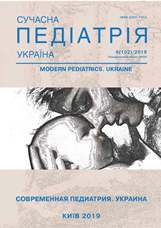Immunotropic activity of furamag in the treatment of recurrent urogenital tract infection in children
Keywords:
children, urinary system, immunity, soluble furaginAbstract
The aim: to increase the therapy effectiveness for recurrent urogenital tract infection in children through the use of the Furamag immunotropic properties.Materials and methods. Under observation were 60 children aged 2 to 6 years in the period of exacerbation of recurrent urogenital tract infections. Two observation groups of 30 children each were formed. Children of the 1st group received Furamag for 7 days; group 2 children received cefixime also for 7 days.
Results. The immunotropic activity of Furamag was manifested by a decrease in the number of children with low indicators: phagocytic index and number, phagocytosis completion index, spontaneous NST-test index, stimulated with staphylococcus NST-test and its index, natural killer CD3-CD16+CD56+, low neutrophil myeloperoxidase activity, decreased serum IgG and IgA, urine secretory sIgA.
Conclusion. The dynamics of the innate and acquired immunity indicators showed the immunotropic activity of the 7-day of Furamag use, which improves the effectiveness of the treatment of recurrent urogenital tract infection in children.
The research was carried out in accordance with the principles of the Helsinki Declaration. The study protocol was approved by the Local Ethics Committee (LEC) of a participating institution. The informed consent of the patient was obtained for conducting the studies.
References
Vyalkova AA, Gritsenko VA. (2017). Urinary tract infection in children: Current aspects of etiological diagnosis and treatment. Russian Bulletin of Perinatology and Pediatrics. 62;1: 99–108. https://doi.org/10.21508/1027-4065-2017-62-1-99-108
Elkina TN, Likhanova MG, Voropay LA, Loginova SA (2018). «Furamag» in the treatment of obstructive chronic pyelonephritis in children. Russian Bulletin of Perinatology and Pediatrics. 63;4: 217.
Zaytseva OV. (2015). Infection and immunity: current issues in pediatric practice. Children infections. 14;1: 36–43. https://doi.org/10.22627/2072-8107-2015-14-1-36-43
Kirillov VI, Bogdanova NA. (2016). Problematic issues of causal treatment for urinary tract infections in children. Russian Bulletin of Perinatology and Pediatrics. 61;6: 32–37. https://doi.org/10.21508/1027-4065-2016-61-6-32-37
Kuryata OV, Frolova YO, Yashenko TD. (2019). Clinical efficacy and safety Furamag in the combined antibacterial therapy of chronic pyelonephritis. The sensitivity profile of UTIs to antibacterial drugs of different classes. Urology. 23;1(88): 66–71. https://doi.org/10.26641/2307-5279.23.1.2019.161666
Mametova Sh. (2012). Modern aspects of diagnosis and treatment of cystitis of children. Vestnik Kaz NMU. 1: 255–257.
Ovcharenko LS, Vertegel AA, Andrienko TG, Samokhin IV, Kryazhev OV, Sheludko DN. (2017). Therapy of recurrent urinary tract infection in children with assessment of the uropathogens sensitivity profile. Sovremennaya pediatriya. 2: 111–116. https://doi.org/10.15574/SP.2017.82.111
Perepanova TS, Volkova EM. (2015). Apropos of pathogenesis of recurrent lower urinary tract infections. Experimental and Clinical Urology. 3: 100–105.
On approval of methodological guidelines for determining the sensitivity of microorganisms to antibacterial drugs: Order of the Ministry of Health of Ukraine No. 167 of April 5, 2007. http://www.moz.gov.ua.
Takhirova RN, Pirnazarova GZ. (2018). Corrective therapy of pneumonia in children with combined nephritis. Academy. 28;1: 82–84.
Aratani Y. (2018). Myeloperoxidase: its role for host defense, inflammation, and neutrophil function. Archives of biochemistry and biophysics. 640: 47–52. https://doi.org/10.1016/j.abb.2018.01.004; PMid:29336940
Budnik TV, Mordovets YM. (2016). The Results of the Study of Microbiologic Pattern of the Urinary Tract Infection in Children from Kyiv and Kyiv Region. Kidneys. 2;16: 21–25. https://doi.org/10.22141/2307-1257.2.16.2016.72744
Dubowski B, Jablonska O, Radziszewski P et al. (2007). Efficacy Of Acute Cystitis Treatment Measured With Immune Parameters. European Urology Supplements. 6;2: 25. https://doi.org/10.1016/S1569-9056(07)60009-8
Foxman B. (2002, Jul 8). Epidemiology of urinary tract infections: incidence, morbidity and economic const. Am J Med. 113;1A: 5S–13S. https://doi.org/10.1016/S0002-9343(02)01054-9
Lazarevic-Pasti T, Leskovac A, Vasic V. (2015). Myeloperoxidase inhibitors as potential drugs. Current drug metabolism. 16;3: 168–190. https://doi.org/10.2174/138920021603150812120640; PMid:26279325
Strazdins V, Cernevskis H. (2018). Soluble Nitrofurans in Recurrent Urinary Tract Infections: Unexpected Findings from 2014 Latvian Study. J. Nephrol. Ther. 8(2): 309. https://doi.org/10.4172/2161-0959.1000309
Utsch B, Klaus G. (2014). Urinalysis in children and adolescents. Dtsch. Arztebl. Int. 111: 617–626. https://doi.org/10.3238/arztebl.2014.0617; PMid:25283761 PMCid:PMC4187024
Yang JH, Bhargava P, McCloskey D et al. (2017). Antibiotic-induced changes to the host metabolic environment inhibit drug efficacy and alter immune function. Cell host & microbe. 22;6: 757-765. https://doi.org/10.1016/j.chom.2017.10.020; PMid:29199098 PMCid:PMC5730482
Downloads
Issue
Section
License
The policy of the Journal “MODERN PEDIATRICS. UKRAINE” is compatible with the vast majority of funders' of open access and self-archiving policies. The journal provides immediate open access route being convinced that everyone – not only scientists - can benefit from research results, and publishes articles exclusively under open access distribution, with a Creative Commons Attribution-Noncommercial 4.0 international license (СС BY-NC).
Authors transfer the copyright to the Journal “MODERN PEDIATRICS. UKRAINE” when the manuscript is accepted for publication. Authors declare that this manuscript has not been published nor is under simultaneous consideration for publication elsewhere. After publication, the articles become freely available on-line to the public.
Readers have the right to use, distribute, and reproduce articles in any medium, provided the articles and the journal are properly cited.
The use of published materials for commercial purposes is strongly prohibited.

